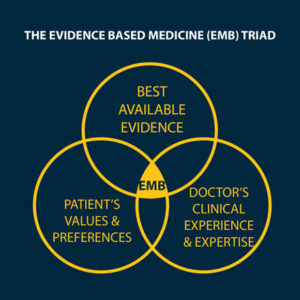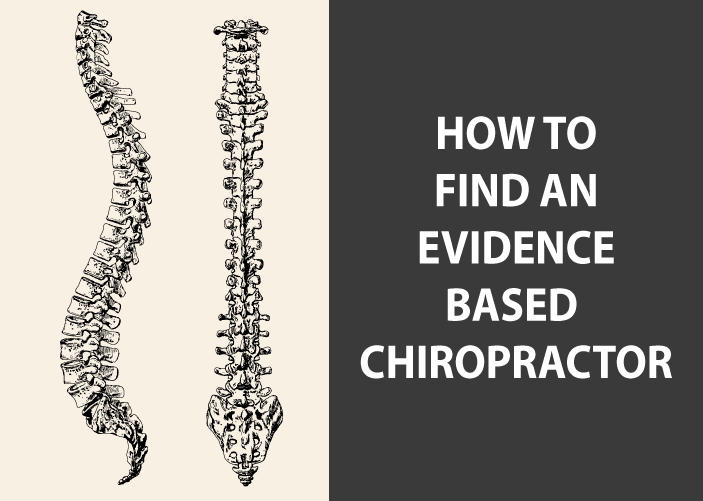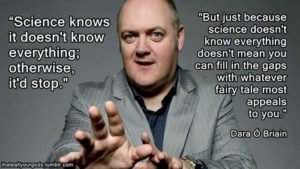What does it mean to be an evidence based Chiropractor? First of all, we need to shine some light on what evidence-based actually means. Most people equate evidence to research, and research only. This is a misconception.
Evidence based medicine (EMB) is composed of three main components, the best available evidence, patient preferences and values, and clinical experience and expertise. These three elements must be used concurrently in order to successfully implement the concept of EBM into clinical practice.(1) Good doctors use both individual clinical expertise and the best available external evidence, and neither alone is enough. (2)

So, how does this translate into the evidence based Chiropractor? Here are some practical tips.
7 signs of an evidence based Chiropractor:
1. Does not hesitate to admit “I don’t know”
Let me just say this…
2. Does not rely on X-ray to diagnose the source of your symptoms
Routine x-ray is a common practice extremely overused in the chiropractic profession. The idea that “x-rays will give my doctor the most important information he/she needs to properly treat me” is a misleading one. Lots of research has CLEARLY indicated that routine x-ray for neck or back pain does NOT associate with benefits, exposes patients to unnecessary harm (radiation), and increases cost. (3-10) Take low back pain as an example. The American College of Physicians and the American Pain Society strongly recommend doctors to not routinely order x-rays or MRI for low back pain. (11) The American College of Radiology recommends no imaging for low back pain within the first 6 weeks unless warning signs are present. (12)
3. Performs a neurologic exam
Since x-ray is not needed in most cases, the diagnosis is mostly made on clinical grounds alone.(7) Is the chiropractor doing the right tests to check out the integrity of your nervous system? And to rule out warning signs? Palpating the spine and a few orthopedic tests are often not enough. We need to focus less on orthopedic testing, but more on neurologic testing. The bottom line is that the chiropractor should at least test for sensation, muscles strength, reflexes, and balance and coordination to uncover neurological changes.
4. Answers the question “what is the pain generator” (13)
There are many structures that can cause chronic pain. The cause of pain may be related to nerve, muscle, fascia, bone, joint, disc, abnormal pain processing, or a combination of the above. Misdiagnosis means that you may get the wrong therapy. The clinical decision to identify a pain source is a complicated one. The diagnosis cannot be based simply on x-ray findings, because most of the time, what you see on the x-rays is NOT THE CAUSE OF YOUR PAIN.(13) To reiterate point #2, routine x-ray is not supported by the evidence. X-ray does not replace a thorough physical examination. And this takes us back to point #3, you really need someone to perform a thorough physical exam to determine where your issue is coming from.
5. Adopts a multimodal and multi-disciplinary approach (13)
This means that the chiropractor uses several different strategies to manage the problem, and does not hesitate to refer patients to other professionals for co-management.
6. Listen to the patient
Remember that patient’s preference is one of the components of EBM. In the chiropractic world, there are many different ways to adjust a patient. Insisting that one method is superior to the others and disregarding patient’s preference are not evidence-based practices. The fact is that when the patient likes one method better than the others, chances are he/she is going to respond better to his/her preferred treatment, regardless of what the doctor prefers.
7. Make reasonable outcome predictions based on experience
I like to let my patients know what they are in for. Of course, I understand that each patient is unique and the responses to treatment may vary. However, an experienced doctor should be able to give you an idea what to expect, the progression of your recovery, and adjust the plan accordingly during the process.
References:
- Kowalski E, Chung KC. The outcomes movement and evidence based medicine in plastic surgery. Clin Plast Surg. 2013 Apr;40(2):241-247.
- Sackett DL. Evidence-based medicine. Semin Perinatol. 1997 Feb;21(!):3-5.
- Allan GM. X-ray scans for nonspecific low back pain. Can Fam Physician. 2012 Mar;58(3):275.
- Chou R, Deyo RA, Jarvik JG. Appropriate use of lumbar imaging for evaluation of low back pain. Radiolo Clin North Am. 2012 Jul;50(4):569-85.
- Srinivas SV, Deyo RA, Berger ZD. Application of “less is more” to low back pain. Arch Intern Med. 2012 Jul 9;172(13):1016-20.
- Ersoy G, Karciogiu O, Enginbas Y, Eray O, Ayrik C. Are cervical spine s-rays mandatory in all blunt trauma patients? Eur J Emerg Med. 1995 Dec;2(4):191-5.
- Binder AI. Cervical spondylosis and neck pain. BMJ. 2007 Mar 10;334(7592):527-531.
- Yadla S, Ratliff JK, Harrop JS. Whiplash: diagnosis, treatment, and associated injuries. Curr Rev Musculoskelet Med. 2008 Mar;1(1):65-68.
- Taylor JAM, Bussieres A. Diagnostic imaging for spinal disorders in the elderly: a narrative review. Chiropr Man Therap. 2012;20:16.
- Andersen JC. Is immediate imaging important in managing low back pain? J Athl Train. 2011 Jan-Feb;46(1):99-102.
- Chou R, et al. Diagnosis and treatment of low back pain: a joint clinical practice guideline from the American College of Physicians and the American Pain Society. Ann Intern Med. 2007 Oct 2;147(7):478-91.
- Davis PC, Wippold FJ, 2nd, Brunberg JA, et al. ACR appropriateness criteria on low back pain. J Am Coll Radiol. 2009;6(6):401-7.
- Allegri M, et al. Mechanisms of low back pain: a guide for diagnosis and therapy. F1000Res. 2016 Jun 28;5.
About the Author
Dr. Lily Semrow is a Board Certified Chiropractic Neurologist who focuses on Neuro-Structural Correction. She has a B.S. in Nutrition and a doctorate in Chiropractic. She has a passion for serving families, and helping people who could not get better through traditional and alternative means.


